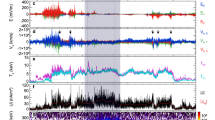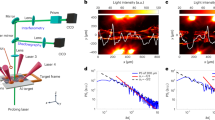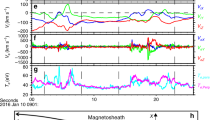Abstract
During magnetic reconnection, the field lines must break and reconnect to release the energy that drives solar and stellar flares1,2 and other explosive events in space3 and in the laboratory4. Exactly how this happens has been unclear, because dissipation is needed to break magnetic field lines and classical collisions are typically weak. Ion–electron drag arising from turbulence5, dubbed ‘anomalous resistivity’, and thermal momentum transport6 are two mechanisms that have been widely invoked. Measurements of enhanced turbulence near reconnection sites in space7,8 and in the laboratory9,10 support the anomalous resistivity idea but there has been no demonstration from measurements that this turbulence produces the necessary enhanced drag11. Here we report computer simulations that show that neither of the two previously favoured mechanisms controls how magnetic field lines reconnect in the plasmas of greatest interest, those in which the magnetic field dominates the energy budget. Rather, we find that when the current layers that form during magnetic reconnection become too intense, they disintegrate and spread into a complex web of filaments that causes the rate of reconnection to increase abruptly. This filamentary web can be explored in the laboratory or in space with satellites that can measure the resulting electromagnetic turbulence.
This is a preview of subscription content, access via your institution
Access options
Subscribe to this journal
Receive 51 print issues and online access
$199.00 per year
only $3.90 per issue
Buy this article
- Purchase on Springer Link
- Instant access to full article PDF
Prices may be subject to local taxes which are calculated during checkout




Similar content being viewed by others
References
Tsuneta, S. Heating and acceleration processes in hot thermal and impulsive solar flares. Astrophys. J. 290, 353–358 (1985)
Priest, E. R. & Forbes, T. G. Magnetic Reconnection: MHD Theory and Applications (Cambridge University Press, 2000)
Baker, D. N., Pulkkinen, T. I., Angelopoulos, V., Baumjohann, W. & McPherron, R. L. Neutral line model of substorms: past results and present view. J. Geophys. Res. 101, 12975–13010 (1996)
Yamada, M. et al. Investigation of magnetic reconnection during a sawtooth crash in a high-temperature tokamak plasma. Phys. Plasmas 1, 3269–3276 (1994)
Galeev, A. A. & Sagdeev, R. Z. in Basic Plasma Physics (eds Galeev, A. A. & Sudan, R. N. ) Vol. 1, 677–731 (North Holland Publishing Company, 1983)
Hesse, M., Kuznetsova, M. & Hoshino, M. The structure of the dissipation region for component reconnection: particle simulations. Geophys. Res. Lett. 29 1563 10.1029/2001GL014714 (2002)
Matsumoto, H., Deng, X. H., Kojima, H. & Anderson, R. R. Observation of electrostatic solitary waves associated with reconnection on the dayside magnetopause boundary. Geophys. Res. Lett. 30 1326 10.1029/2002GL016319 (2003)
Cattell, C. et al. Cluster observations of electron holes in association with magnetotail reconnection and comparison to simulations. J. Geophys. Res. 110, A01211 (2005)
Ji, H. et al. Electromagnetic fluctuations during fast reconnection in a laboratory plasma. Phys. Rev. Lett. 92, 115001 (2004)
Fox, W. et al. Laboratory observation of electron phase-space holes during magnetic reconnection. Phys. Rev. Lett. 101, 255003 (2008)
Eastwood, J., Phan, T. D., Bale, S. D. & Tjulin, A. Observations of turbulence generated by magnetic reconnection. Phys. Rev. Lett. 102, 035001 (2009)
Vasyliunas, V. M. Theoretical models of magnetic field line merging. 1. Rev. Geophys. Space Phys. 13, 303–336 (1975)
Drake, J. F. et al. Formation of electron holes and particle energization during magnetic reconnection. Science 299, 873–877 (2003)
Che, H., Drake, J. F., Swisdak, M. & Yoon, P. H. Electron holes and heating in the reconnection dissipation region. Geophys. Res. Lett. 37 L11105 10.1029/2010GL043608 (2010)
Kaw, P. K., Valeo, E. J. & Rutherford, P. H. Tearing modes in a plasma with magnetic braiding. Phys. Rev. Lett. 43, 1398–1401 (1979)
Drake, J. F., Kleva, R. G. & Mandt, M. E. Structure of thin current layers: implications for magnetic reconnection. Phys. Rev. Lett. 73, 1251–1254 (1994)
Lazarian, A. & Vishniac, E. Reconnection in a weakly stochastic field. Astrophys. J. 517 700 10.1086/307233 (1999)
Kowal, G., Lazarian, A., Vishniac, E. & Otmianowska-Mazur, K. Reconnection in a weakly stochastic magnetic field. Astrophys. J. 700, 63–85 (2009)
Openheim, M. M., Vetoulis, G., Newman, D. L. & Goldman, M. V. Evolution of electron phase-space holes in 3-D. Geophys. Res. Lett. 28, 1891–1894 (2001)
Omura, Y., Matsumoto, H., Miyake, T. & Kojima, H. Electron beam instabilities as a generation mechanism of electrostatic solitary waves in the magnetotail. J. Geophys. Res. 101, 2685–2697 (1996)
McMillan, B. F. & Cairns, I. H. Lower hybrid turbulence driven by parallel currents and associated electron energization. Phys. Plasmas 13 052104 10.1063/1.2198212 (2006)
Goldman, M. V., Newman, D. L. & Pritchett, P. Vlasov simulations of electron holes driven by particle distribution from PIC reconnection simulations with a guide field. Geophys. Res. Lett. 35 L22109 10.1029/2008GL035608 (2008)
Che, H., Drake, J. F., Swisdak, M. & Yoon, P. H. Nonlinear development of streaming instabilities in strongly magnetized plasma. Phys. Rev. Lett. 102, 145004 (2009)
Kingsep, A. S. Chukbar, K. V. & Yan’kov, Y. Y. in Reviews of Plasma Physics (ed. Kadomtsev, B. B. ) Vol. 16, 243–288 (Consultants Bureau, 1990)
Ferraro, N. M. & Rogers, B. N. Turbulence in low-β reconnection. Phys. Plasmas 11, 4382–4389 (2004)
Ricci, P. Brackbill, J. U., Daughton, W. & Lapenta, G. Collisionless magnetic reconnection in the prescence of a guide field. Phys. Plasmas 11, 4102–4114 (2004)
Zeiler, A. et al. Three-dimensional particle simulations of collisionless magnetic reconnection. J. Geophys. Res. 107 1230 10.1029/2001JA000287 (2002)
Pritchett, P. & Coroniti, F. V. Three-dimensional collisionless magnetic reconnection in the presence of a guide field. J. Geophys. Res. 109 A01220 10.1029/2003JA009999 (2004)
Acknowledgements
This work has been supported by the NSF/DOE programme in plasma science and by NASA through the Supporting Research and Technology Program and the Magnetospheric Multiscale Mission Science Team. Computations were carried out in part at the National Energy Research Scientific Computing Center.
Author information
Authors and Affiliations
Contributions
All of the authors made significant contributions to this work. H.C. carried out the particle simulations of reconnection. M.S. carried out simulations of isolated electron current layers. H.C., J.F.D. and M.S. analysed the data from the simulations. All authors discussed the results and commented on the paper.
Corresponding author
Ethics declarations
Competing interests
The authors declare no competing financial interests.
Supplementary information
Supplementary Information
The file contains Supplementary Text and Supplementary Figure 1. (PDF 2054 kb)
Supplementary Movie 1
The movie shows the time evolution of the electron current from a 3-D simulation of magnetic reconnection. The simulation has ambient out-of-plane magnetic field that is 2.5 times that of the reversed magnetic field. (MOV 15392 kb)
Rights and permissions
About this article
Cite this article
Che, H., Drake, J. & Swisdak, M. A current filamentation mechanism for breaking magnetic field lines during reconnection. Nature 474, 184–187 (2011). https://doi.org/10.1038/nature10091
Received:
Accepted:
Published:
Issue Date:
DOI: https://doi.org/10.1038/nature10091
This article is cited by
-
Recent progress on magnetic reconnection by in situ measurements
Reviews of Modern Plasma Physics (2023)
-
Three-dimensional network of filamentary currents and super-thermal electrons during magnetotail magnetic reconnection
Nature Communications (2022)
-
Direct observations of anomalous resistivity and diffusion in collisionless plasma
Nature Communications (2022)
-
Magnetic reconnection in the era of exascale computing and multiscale experiments
Nature Reviews Physics (2022)
-
Kinetic properties of collisionless magnetic reconnection in space plasma: in situ observations
Reviews of Modern Plasma Physics (2022)
Comments
By submitting a comment you agree to abide by our Terms and Community Guidelines. If you find something abusive or that does not comply with our terms or guidelines please flag it as inappropriate.



